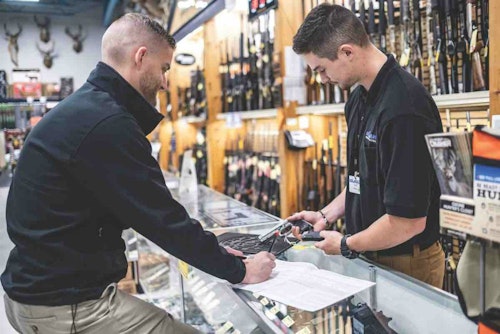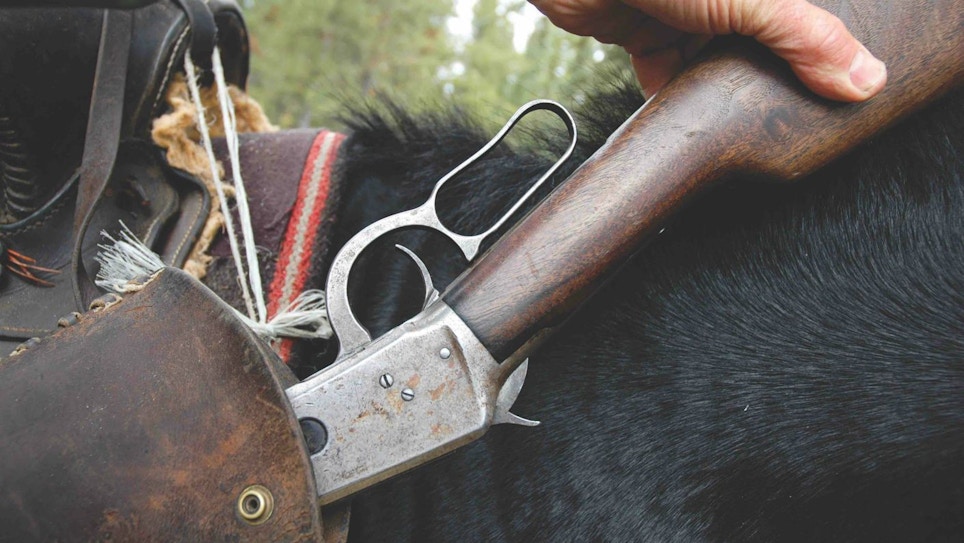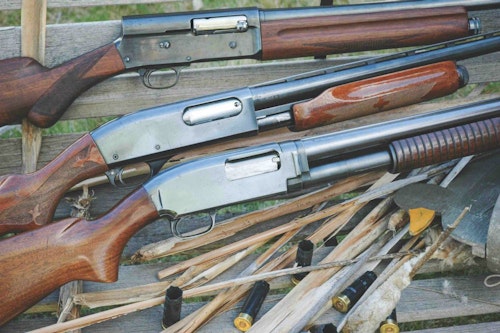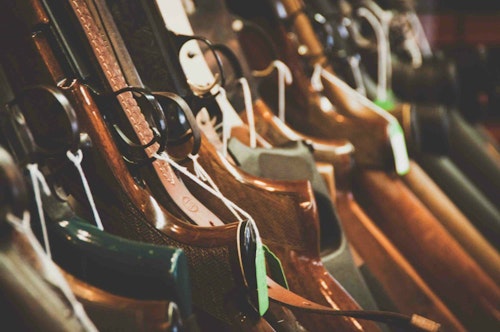One afternoon last summer, I walked into a gun shop, spotted a rifle I liked, and paid asking price for it — no checking the competition on a smartphone. The rifle just wasn’t available elsewhere. Secondhand, it bore light field scars, but also the machining and handwork of another time. I can’t say what the shop’s proprietor got from that sale, only that it was what he wanted.
If you’re counting fewer customers these days and the faithful stop by less frequently, you can’t expect strong sales. Automobile dealers know that tire-kickers and test drives pave the path to profits. The more eyes and hands they can put on shiny metal, and the more fannies in the seats, the more cars they’ll sell. The daily directive is simple: Bring more people in and keep them longer. It’s also the mantra of successful gun shops.
A couple of weeks ago at this writing, the CEO of a major gun firm declared: “The bloom is off AR-15s.” His company manufactures a suite of firearms, including ARs. “The market changes. We must offer what it demands,” he declared. That’s easier said than done if you must invest in design, tooling, manufacturing, proofing, marketing, packaging and delivery before demand shifts yet again.
Selling guns is less complicated. Shops are cheaper than factories, and gun racks and display cases are a real bargain compared to CNC machines. You needn’t tie up capital in raw material or pay engineers and skilled machinists or tend a complex off-site pipeline.
All you have to do is stock the guns people want, price them intelligently and convince customers to buy them.
New products bring traffic, but any new firearm you can get is also available elsewhere, so your pool of customers must be shared. Increasingly, too, gun enthusiasts include people with little interest in new firearms. They pine for guns they remember from their youth, or rare or historically significant arms. Some seek collectibles or a gun no longer produced to fill a reserved spot in their rack at home.
There’s still a market for purse pistols, entry-level deer rifles, and mean-looking guns with high-cap magazines. But does your shop offer anything really interesting? Black stampings and polymer grips won’t win hearts forever. Ditto for dipped camo patterns and 6-pound triggers. In many gun stores, traffic is migrating to secondhand racks. Said one shop-owner: “Our regulars — customers who stop by weekly to see what’s come in — are mostly middle-aged guys. They know guns and they buy guns, but they’re picky.” While we talked, one of these fellows entered: silver hair, tattered ball cap, plaid shirt, roomy jeans. He cruised by the ranks of gleaming new long guns and auto pistols under glass to scrutinize the secondhand racks. “Eight visits out of 10 he buys nothing,” the shop owner told me, “but he’s here every Tuesday. Do the math.”

The Appeal of History
While the future of shooting sports does indeed belong to young shooters, most available cash is still in the pockets of their elders. Serving youth and the one-time buyer who wants to try grouse hunting doesn’t preclude you from courting enthusiasts like me. Used guns of early manufacture appeal to me, even those used hard. Each has a history — travels and travails — beyond the factory floor. History gives a firearm more than scuffs and age, just as a baseball Ted Williams slammed into the stands is more than secondhand horsehide.
Remember walnut? It once graced rifles and shotguns. Hand-fitted and unique in grain and color, each stock made the firearm unique — as did iron sights and rust blue and triggers that broke like tiny icicles. Indeed, a gun’s cachet can have more to do with manufacture than use. I recall visiting Winchester’s old New Haven plant in its dotage, empty rooms echoing the distant pop and creak of an occasional footfall on oil-soaked floors that during WWII bore the traffic and tooling of 20,000 workers — men and women spurred in their labors by memories of the Great War, who tended engines with massive flywheels and machinery driven by overhead belts. The upper windows, I saw, were still blacked, a precaution against Nazi air raids. To my nostalgic soul, any gun boxed in this ancient brick behemoth was and is intrinsically more desirable than one cut exactly like the next of its type by a five-axis CNC machine under fluorescent lights on polymer-finished concrete in an industrial park.
I also prowl used-gun racks because I like the solid, simple, carefully-fitted firearms now too costly to produce for the proletariat — guns of steel and walnut, with the cosmetic imperfections and glass-smooth function of handwork, without superfluous safeties, plated pot-metal triggers or glittery finish.
Then there’s the allure of finding a sleeper that’s underpriced, or one in fine condition to replace a sound but scarred specimen in the home stable. The prospect of a surprise is also a draw. I wasn’t on the hunt for a lovely Swedish Mauser I bought recently, or the equally appealing Krag I couldn’t afford.
Enthusiasts include an eclectic mix of people, some with narrow focus. No matter how comprehensive your selection is, only by chance will you sell a used gun to an advanced collector. But history, scarcity and obsolescence apply not only to collectibles. Guns produced in quantity for hard use may be relatively rare in excellent condition. Savage’s 1899 is one example, Winchester’s Model 12 another, S&W’s .45 Hand Ejector (Model of 1917) yet another. These gems can suck traffic to your shop when ranks of black self-loaders gather dust.
If aging firearms don’t tug at your heart, consider their utility. I’ve yet to pick up a secondhand firearm sold as functional that didn’t function. On-target performance matches what you’d get with respective models fresh off the line. Rifle and handgun barrels retain their accuracy for many more rounds than most hunters fire. Shotgun patterns repeat faithfully for decades. Excepting rifles fed fast in frequent competition with frisky loads, ruinous throat erosion is uncommon. Corrosive priming has been obsolete for nearly a century. Besides, even pitted grooves and faint lands can still direct bullets. Carbines dating to the Depression have blessed me with golf-ball-size groups despite their chimney-like bores.
Guns that have endured frontier use and neglect won’t walk into your shop often, but those that do still carry profit. Customers keen to pick up an early Colt without draining Junior’s college account know they must tolerate bore shadows, thin blue and cosmetic scars.
The difference between collectible and desirable can hinge on more than condition. Any gun with provenance linking it to a celebrity, good or bad, can bring a premium. Buy without the provenance, and you should pay less. Of course, the claim that a pistol passed from Wild Bill Hickok to George Custer to Annie Oakley might not pan out, and a serial number can fail to link a gun with all who used it.
I came to lever-actions late. In my youth, new Winchester 94s listed for $89.50. These were pre-1964 carbines. For a couple of decades thereafter, you could snap up lightly used “deer rifles” for $200. No more — prices have climbed steeply. Less common Winchesters like the 1886 and Model 71 now start in four figures; the best specimens make a dangerous-game safari look cheap.
The same truths apply to shotgun country in the Southeast, where Parkers and Foxes hold sway and centerfire rifles sell as briskly as snow shovels. Of course, when you buy or trade for used guns, you consider local traditions and the yield of the local bush. If your customers motor up in 2WD pickups with bird dog condominiums in the back, better go light on .30 magnums.
What to Buy and Sell
An indispensable resource for anyone dealing in used firearms is the Blue Book of Gun Values, published annually for decades by S.P. Fjestad, who passed away last year. As thick as a metropolitan phone book with more than 2,500 pages, this comprehensive work lists thousands of shotguns, rifles and handguns, foreign and domestic. From Azanza & Arrizabalaga (Spanish) to Antonio Zoli (Italian), if the firearm was commercially manufactured, it’s almost surely here, with notes on special features and production runs. Market prices are keyed to seven levels of condition. There’s a trademark index and a section with serial ranges by year, as well as a glossary.
If you’re going to buy used guns or accept them in trade to resell, you need an eye for detail: Differences in market value between sub-models, manufacturing dates, chamberings and grades of appearance affect your profit. Pay too much, and the price you put on the tag will relegate that gun to months on the rack. Changes in design or manufacture, or a perceived slump in quality, affect pricing. Of the 581,471 Model 70 Winchesters shipped before that rifle’s 1963 overhaul, only 362 were barreled to .300 Savage, just 404 in .35 Remington. Those now fetch exorbitant sums. But there’s strong demand even for pre-’64 M70s in .30-06. Winchester built 208,218 of those!
Alterations matter. Little changes like a hole drilled for a scope mount screw can drain significant value from an otherwise factory-original firearm. Aftermarket sights and buttpads aren’t fatal if they’ve been added without violating the barrel or buttstock, but lopped barrels and butts will force deep discounts. Factory refinish that’s hard to detect will slip by many customers; others will accept it with a shrug. Re-blue and stock refinishing by amateurs send “collector value” into a tailspin. Even hunters looking for a 1950s-era lever rifle or pump shotgun, or a pinned S&W revolver, may prefer honest wear to a fresh finish.
Not to discount the market for guns whose provenance and cosmetic integrity matter not. Utility, price and “feel” clinch many sales. Then there’s the inscrutable appeal of a unique firearm to just the right buyer — like the chemistry between two teenagers, neither of whom will ever make the football team or cheerleading squad or score 1200 on the SAT. At a gun show decades back, I spied what appeared to be a Winchester M54 stock with a patchwork of additional wood fitting it snugly to a re-barreled 98 Mauser. Intrigued by the obvious effort in this project and impressed by the result, I threw this hybrid to my shoulder. The bead centered instantly in the aperture sight. Like a mutt with unpapered lineage but the promise of brilliance, this rifle followed me home.
“Sporterized” infantry arms, once common, have drifted into obscurity as supplies of bolt-action battle rifles have diminished. Still, they turn up in the hands of aging hunters asking a few rubles at local gun counters. Over the years I’ve ferreted out three fetchingly modified 1903 Springfields, also an SMLE better fitted and finished than the one I re-stocked as a teenager.
Making Money
Restrictions in some states requiring all gun sales to be conducted through licensed dealers have diminished attendance at gun shows — as legislation in 1968 throttled traffic in mail-order firearms. Such lamentable laws, as ineffective as they are at curbing crime, benefit shops that sell used guns. The most convenient place to buy discontinued or secondhand firearms is a brick-and-mortar store.
To best tap the secondhand market, let customers know you accept trade-ins and can appraise used guns. The most valuable firearms from estates often wind up with appraisers. “That service pays me twice,” a proprietor told me. “I charge to appraise, and I get first crack at guns that have been closeted for years.” You’re smart to acknowledge a conflict of interest here. The customer will appreciate it, and you shouldn’t lose your chance to buy.
Secondhand guns deserve better than second-tier status in cobbled racks or wedged between new firearms. Better to display them prominently and apart from new firearms, so buyers like me notice them right away. Mark the model, chambering and price on a hang tag anyone can read without corrective glasses or lifting the firearm. No trigger locks, please.
Cabela’s stores feature plush “Gun Libraries” that add perceived value to used firearms, but you can build atmosphere at much a lesser cost. Dedicate a corner or section, then hang period posters and calendars, maybe a dash of tasteful taxidermy. Images of film stars with iconic firearms — John Wayne and a Winchester, Tom Selleck with a Sharps — evoke nostalgia that can help you sell period guns. Add hunting photos, vintage cartridge boxes, gun belts, duck decoys, bullet boards, old copies of periodicals like Gun Digest and American Rifleman, and tin reproductions of industry placards. Set up a 1940s-era loading bench, with period guns and tools.
You want visitors to relax and perhaps remember, to enjoy a few moments in another era. As with automobiles, smartphones and beer, you’re peddling more than product — you’re selling a lifestyle!
Remind buyers of related items: ammunition, but also gun cases, holsters, sights, scopes, slings, chokes, targets, cleaning supplies and hand-loading tools and components.
Offering guarantees on used firearms is your call. Declaring every sale final won’t prevent you from acting charitably later on. It’s the frontier way to deal in used guns, and perhaps still the best.
Sidebar: Top Tips for Selling Used Guns
Having bought and sold hundreds of firearms, I’ve learned the following:
- Brands matter. Guns with a name other than the manufacturer’s (Glenfield, not Marlin) bring less.
- Pretty wood adds value to an otherwise ordinary gun; so do screws that have never been touched.
- The original box, hangtag and paperwork significantly boost prices of collectible firearms.
- A cheap scope and carrying strap add no value to a fine rifle. A pristine, period scope and sling can.
- Custom-built rifles seldom bring near replacement cost and are often hard to sell, even at discount.
A little attention to a neglected or lightly scarred firearm can give it rack appeal:
- Cleaning a bore is like detailing a car’s interior. It adds sparkle and contributes to a good first impression.
- A light scrub with a toothbrush and boiled linseed oil renews checkering. Follow with a dry brush.
- Replacing or reshaping a disfigured or ill-fitted aftermarket recoil pad gives the stock a crisp profile.
Sidebar: Cartridge Equivalents
Re-barreled guns not stamped for the chambering deter most buyers — but don’t instantly dismiss unfamiliar numbers! You can fire .38 Specials in .357 chambers, .44 Specials in .44 Magnums, .45 Colts in .454 Casulls. Likewise, you can use .25-35 ammo in chambers cut for the .25-36 Marlin. Rifles in .38-55 accept .375 Winchester ammo — but its high pressure makes it hazardous in vintage .38-55s. The .244 and 6mm Remington are identical, so too the 7x57, 7mm Mauser and .275 Rigby. Early Winchester M70s stamped .300 Magnum are bored for the .300 H&H, as the .300 Winchester and .300 Weatherby hadn’t yet appeared.
Cartridge names don’t all reflect bullet diameter. The .256 Newton fires a 6.5mm (.264) missile. The .386 bullets of the .41 Colt would rattle down a .41 Magnum barrel, groove diameter .410.









